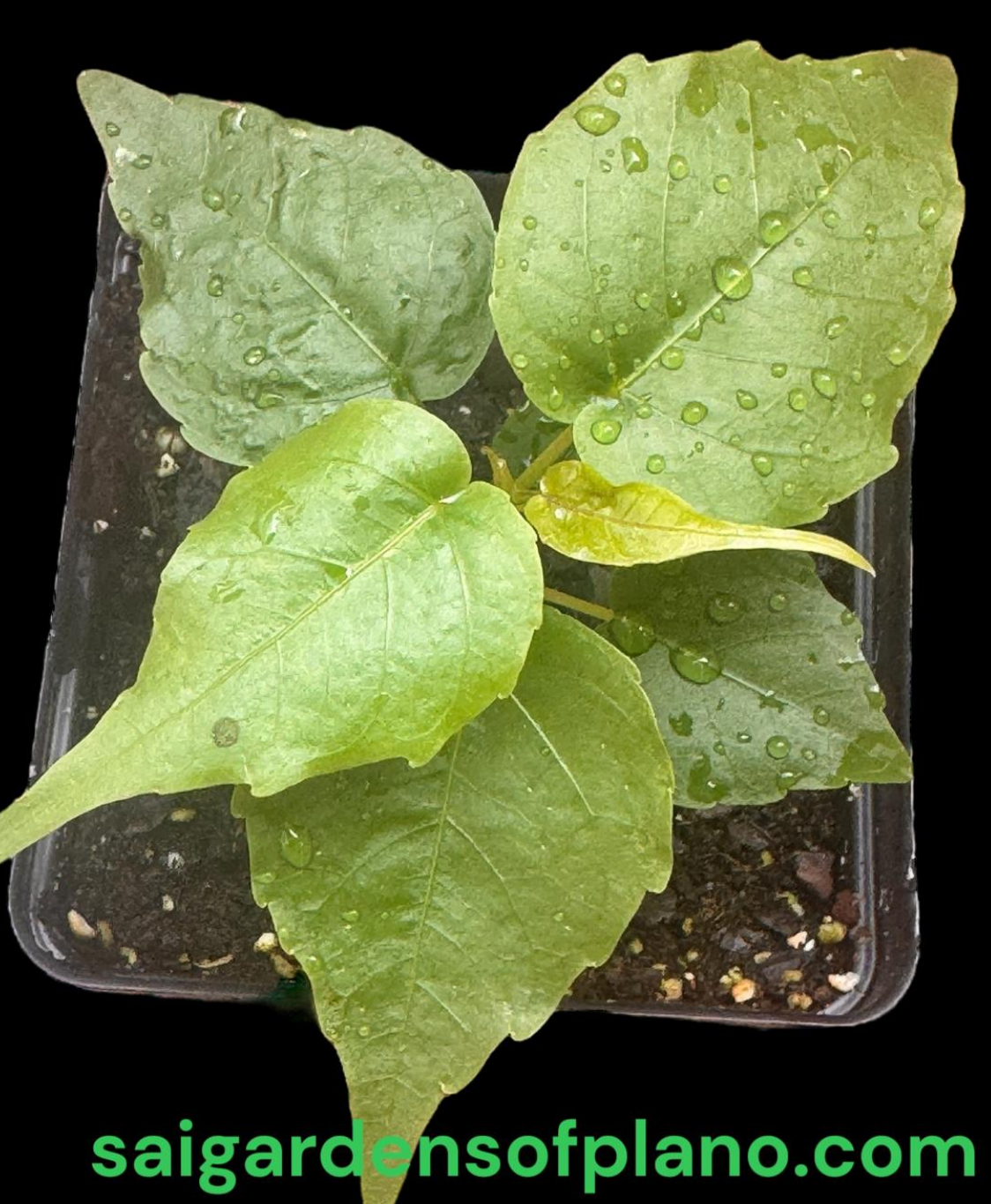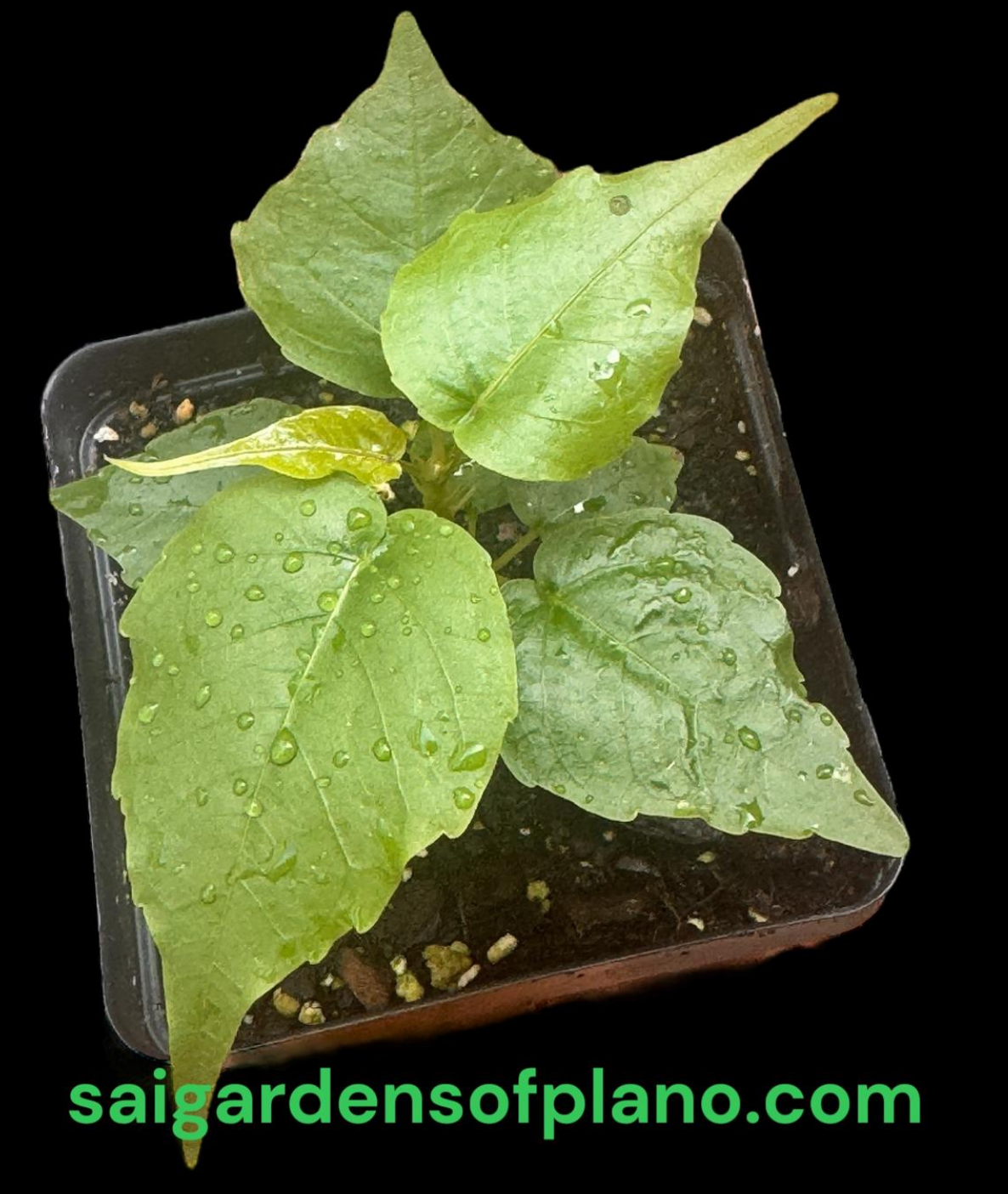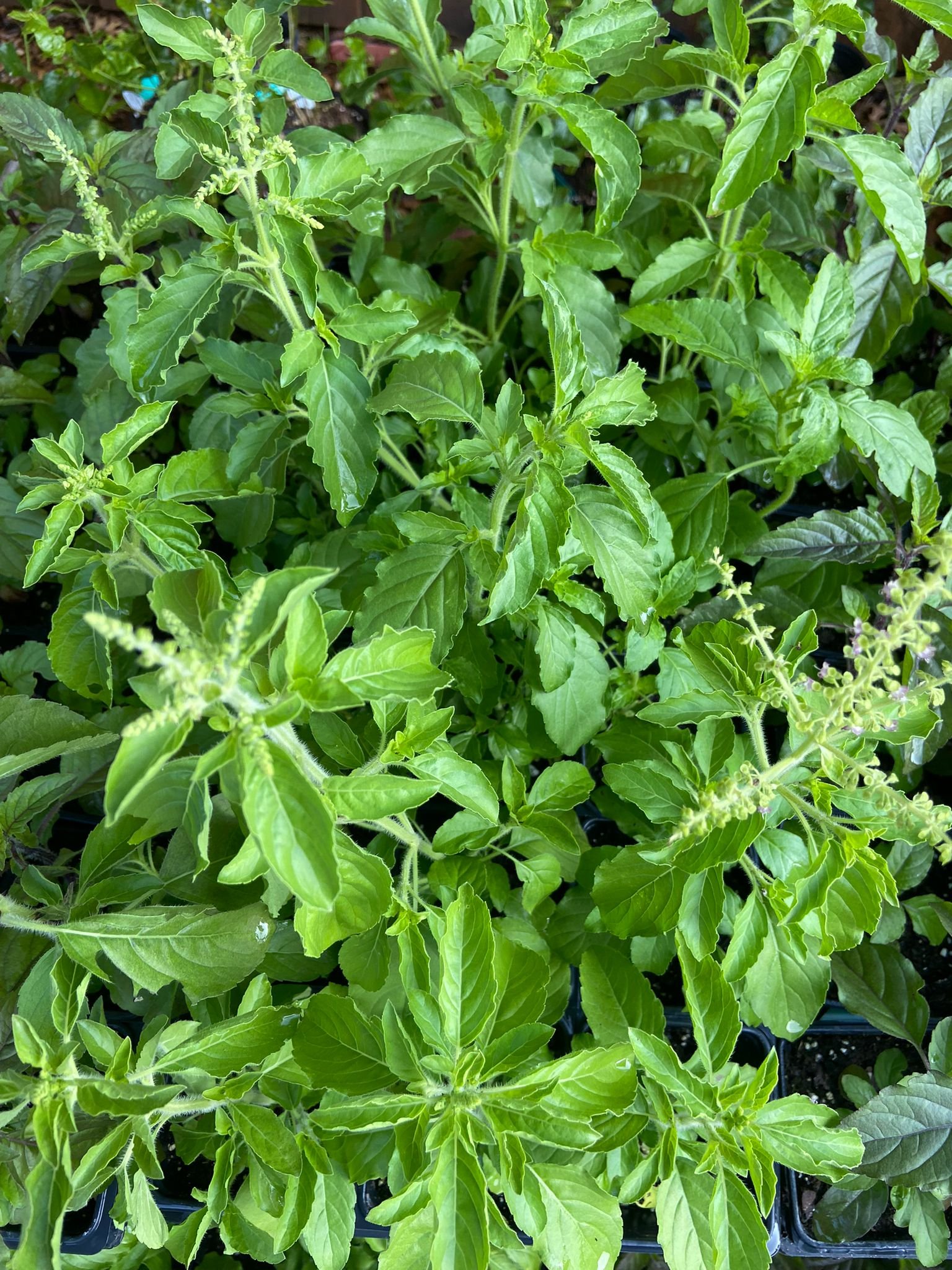 Image 1 of 2
Image 1 of 2

 Image 2 of 2
Image 2 of 2



Peepal Tree Sapling / Arasa Maram / Sacred Fig Tree Sapling
4-inch container. Sapling.
The Peepal tree, scientifically known as Ficus religiosa, is a highly revered and significant tree, particularly in the Indian subcontinent. It's often called the "sacred fig" and is deeply intertwined with several major religions that originated in the region, including Hinduism, Buddhism, Sikhism, and Jainism.
1. Botanical Characteristics:
Appearance: It's a large, often semi-evergreen or dry-season deciduous tree that can grow up to 30 meters tall with a trunk diameter of up to 3 meters.
Leaves: The leaves are distinctively heart-shaped (cordate) with a long, extended drip tip. They are typically 10-17 cm long and 8-12 cm broad.
Fruits: The tree produces small figs, about 1-1.5 cm in diameter, which ripen from green to purple.
Lifespan: Peepal trees are known for their exceptional longevity, with some specimens living for hundreds, and even over 2000, years.
2. Spiritual and Cultural Significance:
Bodhi Tree: Most famously, it's known as the "Bodhi Tree" or "Bo Tree" because Siddhartha Gautama (Buddha) attained enlightenment while meditating under a Peepal tree. This makes it incredibly sacred in Buddhism, symbolizing spiritual awakening and wisdom.
Hinduism: In Hinduism, the Peepal tree holds immense religious importance.
Divine Abode: It's believed to house the Hindu trinity: Lord Brahma in its roots, Lord Vishnu in its trunk, and Lord Shiva in its leaves.
Lord Krishna: Lord Krishna is also associated with the Peepal tree, having stated in the Bhagavad Gita, "I am the Peepal tree among the trees." He is also believed to have died under a Peepal tree.
Rituals: Worshipping the Peepal tree, often by offering water or performing circumambulation, is believed to bring good fortune, remove obstacles, ensure longevity, and even bless women with children. Saturdays are considered particularly auspicious for worshipping the tree, as it's believed that Lord Vishnu and Goddess Lakshmi reside on the tree on this day.
Symbolism: It symbolizes sustenance, enlightenment, divine connection, and the eternal nature of the soul due to its ability to regenerate.
Ancient Roots: The veneration of the Peepal tree dates back to ancient times, with peepal leaf motifs found in pottery from the Helmand culture (3rd millennium BCE) and the Indus Valley Civilization.
National Recognition: The Bharat Ratna, India's highest civilian award, is modeled on a Peepal leaf.
3. Medicinal Uses (Traditional and Ayurvedic): Various parts of the Peepal tree – including leaves, bark, roots, fruits, and latex – have been traditionally used in Ayurvedic medicine for a wide range of ailments. Some of its reported medicinal properties and traditional uses include:
Respiratory Issues: Used for asthma, cough, and other respiratory problems.
Digestive Health: Helpful for diarrhea, dysentery, stomach pain, vomiting, and constipation.
Skin Conditions: Applied for wound healing, eczema, itching, skin eruptions, and improving complexion due to its antimicrobial and anti-inflammatory properties.
Anti-inflammatory and Analgesic: Used to relieve pain and inflammation, including joint pain (rheumatism).
Antidiabetic: Traditionally used to help manage blood sugar levels.
Heart Health: Some traditional practices suggest it can help with heart weakness and palpitations.
Other Uses: Also traditionally used for ear pain, toothache, bleeding (epistaxis), and even for its potential as an anthelmintic (expelling parasitic worms).
Please do your own research about this plant.
4-inch container. Sapling.
The Peepal tree, scientifically known as Ficus religiosa, is a highly revered and significant tree, particularly in the Indian subcontinent. It's often called the "sacred fig" and is deeply intertwined with several major religions that originated in the region, including Hinduism, Buddhism, Sikhism, and Jainism.
1. Botanical Characteristics:
Appearance: It's a large, often semi-evergreen or dry-season deciduous tree that can grow up to 30 meters tall with a trunk diameter of up to 3 meters.
Leaves: The leaves are distinctively heart-shaped (cordate) with a long, extended drip tip. They are typically 10-17 cm long and 8-12 cm broad.
Fruits: The tree produces small figs, about 1-1.5 cm in diameter, which ripen from green to purple.
Lifespan: Peepal trees are known for their exceptional longevity, with some specimens living for hundreds, and even over 2000, years.
2. Spiritual and Cultural Significance:
Bodhi Tree: Most famously, it's known as the "Bodhi Tree" or "Bo Tree" because Siddhartha Gautama (Buddha) attained enlightenment while meditating under a Peepal tree. This makes it incredibly sacred in Buddhism, symbolizing spiritual awakening and wisdom.
Hinduism: In Hinduism, the Peepal tree holds immense religious importance.
Divine Abode: It's believed to house the Hindu trinity: Lord Brahma in its roots, Lord Vishnu in its trunk, and Lord Shiva in its leaves.
Lord Krishna: Lord Krishna is also associated with the Peepal tree, having stated in the Bhagavad Gita, "I am the Peepal tree among the trees." He is also believed to have died under a Peepal tree.
Rituals: Worshipping the Peepal tree, often by offering water or performing circumambulation, is believed to bring good fortune, remove obstacles, ensure longevity, and even bless women with children. Saturdays are considered particularly auspicious for worshipping the tree, as it's believed that Lord Vishnu and Goddess Lakshmi reside on the tree on this day.
Symbolism: It symbolizes sustenance, enlightenment, divine connection, and the eternal nature of the soul due to its ability to regenerate.
Ancient Roots: The veneration of the Peepal tree dates back to ancient times, with peepal leaf motifs found in pottery from the Helmand culture (3rd millennium BCE) and the Indus Valley Civilization.
National Recognition: The Bharat Ratna, India's highest civilian award, is modeled on a Peepal leaf.
3. Medicinal Uses (Traditional and Ayurvedic): Various parts of the Peepal tree – including leaves, bark, roots, fruits, and latex – have been traditionally used in Ayurvedic medicine for a wide range of ailments. Some of its reported medicinal properties and traditional uses include:
Respiratory Issues: Used for asthma, cough, and other respiratory problems.
Digestive Health: Helpful for diarrhea, dysentery, stomach pain, vomiting, and constipation.
Skin Conditions: Applied for wound healing, eczema, itching, skin eruptions, and improving complexion due to its antimicrobial and anti-inflammatory properties.
Anti-inflammatory and Analgesic: Used to relieve pain and inflammation, including joint pain (rheumatism).
Antidiabetic: Traditionally used to help manage blood sugar levels.
Heart Health: Some traditional practices suggest it can help with heart weakness and palpitations.
Other Uses: Also traditionally used for ear pain, toothache, bleeding (epistaxis), and even for its potential as an anthelmintic (expelling parasitic worms).
Please do your own research about this plant.
4-inch container. Sapling.
The Peepal tree, scientifically known as Ficus religiosa, is a highly revered and significant tree, particularly in the Indian subcontinent. It's often called the "sacred fig" and is deeply intertwined with several major religions that originated in the region, including Hinduism, Buddhism, Sikhism, and Jainism.
1. Botanical Characteristics:
Appearance: It's a large, often semi-evergreen or dry-season deciduous tree that can grow up to 30 meters tall with a trunk diameter of up to 3 meters.
Leaves: The leaves are distinctively heart-shaped (cordate) with a long, extended drip tip. They are typically 10-17 cm long and 8-12 cm broad.
Fruits: The tree produces small figs, about 1-1.5 cm in diameter, which ripen from green to purple.
Lifespan: Peepal trees are known for their exceptional longevity, with some specimens living for hundreds, and even over 2000, years.
2. Spiritual and Cultural Significance:
Bodhi Tree: Most famously, it's known as the "Bodhi Tree" or "Bo Tree" because Siddhartha Gautama (Buddha) attained enlightenment while meditating under a Peepal tree. This makes it incredibly sacred in Buddhism, symbolizing spiritual awakening and wisdom.
Hinduism: In Hinduism, the Peepal tree holds immense religious importance.
Divine Abode: It's believed to house the Hindu trinity: Lord Brahma in its roots, Lord Vishnu in its trunk, and Lord Shiva in its leaves.
Lord Krishna: Lord Krishna is also associated with the Peepal tree, having stated in the Bhagavad Gita, "I am the Peepal tree among the trees." He is also believed to have died under a Peepal tree.
Rituals: Worshipping the Peepal tree, often by offering water or performing circumambulation, is believed to bring good fortune, remove obstacles, ensure longevity, and even bless women with children. Saturdays are considered particularly auspicious for worshipping the tree, as it's believed that Lord Vishnu and Goddess Lakshmi reside on the tree on this day.
Symbolism: It symbolizes sustenance, enlightenment, divine connection, and the eternal nature of the soul due to its ability to regenerate.
Ancient Roots: The veneration of the Peepal tree dates back to ancient times, with peepal leaf motifs found in pottery from the Helmand culture (3rd millennium BCE) and the Indus Valley Civilization.
National Recognition: The Bharat Ratna, India's highest civilian award, is modeled on a Peepal leaf.
3. Medicinal Uses (Traditional and Ayurvedic): Various parts of the Peepal tree – including leaves, bark, roots, fruits, and latex – have been traditionally used in Ayurvedic medicine for a wide range of ailments. Some of its reported medicinal properties and traditional uses include:
Respiratory Issues: Used for asthma, cough, and other respiratory problems.
Digestive Health: Helpful for diarrhea, dysentery, stomach pain, vomiting, and constipation.
Skin Conditions: Applied for wound healing, eczema, itching, skin eruptions, and improving complexion due to its antimicrobial and anti-inflammatory properties.
Anti-inflammatory and Analgesic: Used to relieve pain and inflammation, including joint pain (rheumatism).
Antidiabetic: Traditionally used to help manage blood sugar levels.
Heart Health: Some traditional practices suggest it can help with heart weakness and palpitations.
Other Uses: Also traditionally used for ear pain, toothache, bleeding (epistaxis), and even for its potential as an anthelmintic (expelling parasitic worms).
Please do your own research about this plant.












